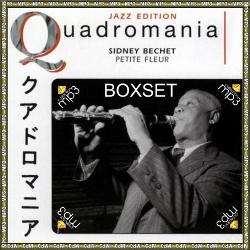Sidney Bechet – Petite Fleur (Quadromania) [2005]
Sidney Bechet – Petite Fleur (Quadromania) [2005]

CD 1 1.Jazz Me Blues 2.Blues Horizon 3.Muskrat Ramble 4.You've Got Me Walkin' And Talkin' To Myself 5.Quite Please 6.Cliff's Boogie Blues 7.Jeepers Creepers 8.High Society play 9.Salty Dog 10.Weary Blues 11.Jackass Blues 12.Milenberg Joys 13.Lord Let Me In The Lifeboard 14.Days Beyond Recall 15.Porto Rico play 16.Up In Sidney's Flat 17.Quincy Street Stomp (Blame It On The Blues) 18.Old Stack O'lee Blues CD 2 1.Royal Garden Blues 2.Slow Blues 3.Old Fashioned Love 4.Fast Blues 5.Bugle Blues 6.Spreading Joy 7.I Had It But It's All Gone 8.Polka Dot Stomp play 9.Kansas City Man Blues 10.Buddy Bolden Stomp 11.Song Of Songs 12.My Woman's Blues 13.Song Of Songs 14.Just One Of This Things 15.Love For Sale play 16.Laura 17.Shake 'em Up 18.Sister Kate 19.Tiger Rag CD 3 1.Tin Roof Blues 2.I've Found A New Baby 3.Nobody Knows You When You're Down And Out 4.When The Saints Go Marching In 5.I Got Rhythm 6.September Song play 7.Who! 8.Song Of The Medina 9.Maryland, My Maryland 10.Careless Love 11.Egyptian Fantasy 12.Basin Street Blues play 13.Cake Walking Babies 14.Tailgate Ramble 15.At The Jazz Band Ball 16.Joshua Fit The Battle Of Jericho 17.Fidgety Feet 18.Honeysucke Rose 19.Coquette 20.High Society 21.On The Sunny Side Of The Street 22.Sugar CD 4 1.Muskrat Ramble 2.St. Louis Blues 3.Sweet Georgia Brown 4.Summertime 5.I Found A New Baby 6.September Song 7.High Society 8.Dippermouth Blues 9.I Got Rhythm 10.Frankie And Johnny 11.Casey Jones play 12.Society Blues 13.Petite Fleur play
Sidney Bechet (May 14, 1897 – May 14, 1959) was an American jazz saxophonist, clarinetist, and composer.
He was one of the first important soloists in jazz (beating cornetist and trumpeter Louis Armstrong to the recording studio by several months and later playing duets with Armstrong), and was perhaps the first notable jazz saxophonist. Forceful delivery, well-constructed improvisations, and a distinctive, wide vibrato characterized Bechet's playing.
Bechet's erratic temperament hampered his career, however, and not until the late 1940s did he earn wide acclaim. Bechet successfully composed in jazz, pop-tune, and extended concert work forms. He knew how to read music, but chose not to due to his highly developed inner ear; he developed his own fingering system and he never played section parts in a big band or swing-style combo. His recordings often have been reissued.
Some of the highlights of his career include 1923 sides with Louis Armstrong in "Clarence Williams Blue Five"; the 1932, 1940, 1941 "New Orleans Feetwarmers" sides; a 1938 "Tommy Ladnier Orchestra" session "Weary Blues", "Really the Blues"); a hit 1938 recording of "Summertime"; and various versions of his own composition, "Petite Fleur".
In 1939, Bechet co-led a group with pianist Willie "The Lion" Smith that recorded several early versions of what was later called "Latin Jazz", adapting traditional Meringue, Rhumba and Haitian songs to the jazz idiom. Bechet in New York in 1947
On July 28, 1940, Sidney Bechet made a guest appearance on NBC Radio's The Chamber Music Society of Lower Basin Street show, playing two of his show-pieces ("Shake It and Break It" and "St. Louis Blues") with Henry Levine's dixieland band. Levine invited Bechet into the RCA Victor recording studio (on 24th Street in New York City), where Bechet lent his soprano sax to Levine's traditional arrangement of "Muskrat Ramble." On April 18, 1941, as an early experiment in overdubbing at Victor, Bechet recorded a version of the pop song "The Sheik of Araby", playing six different instruments: clarinet, soprano saxophone, tenor saxophone, piano, bass, and drums. A theretofore unissued master of this recording was included in the 1965 LP Bechet of New Orleans, issued by RCA Victor as LPV-510. On the liner notes, George Hoeffer quotes Sidney as follows: "I started by playing The Sheik on piano, and played the drums while listening to the piano. I meant to play all the rhythm instruments, but got all mixed up and grabbed my soprano, then the bass, then the tenor saxophone, and finally finished up with the clarinet."
In 1944, 1946, and 1953 he recorded and performed in concert with Chicago Jazz Pianist and Vibraphonist Max Miller, private recordings which are part of the Max Miller archive and have never been released. These concerts and recordings are covered completely in John Chilton's great book on Bechet.
Bechet was an important influence on alto saxophonist Johnny Hodges, who studied with Bechet as a teenager. In 1968, Bechet was inducted into the Down Beat Jazz Hall of Fame.
Sidney Bechet (ur. 14 maja 1897 w Nowym Orleanie, zm. 14 maja 1959 w Paryżu) – amerykański saksofonista, klarnecista i kompozytor jazzowy.
Był najwybitniejszym po Louisie Armstrongu jazzmenem z Nowego Orleanu. Początkowo grał na klarnecie. W 1919 wyruszył ze swoim big bandem na tournée po Europie i tam kupił saksofon sopranowy. Od tej pory znany był jako jeden z najwybitniejszych wirtuozów tego instrumentu w jazzie. Jako pierwszy zaczął tworzyć utwory bez tematu bazującego na piosence, a jedynie na strukturze harmonicznej.
Podczas kryzysu gospodarczego prowadził sklep krawiecki. W 1938 znów wrócił do muzyki. Odniósł sukces na koncercie zorganizowanym przez Johna Hammonda w Carnegie Hall. Potem na stałe przeniósł się do Paryża. Największe przeboje: "Petit fleur", "Indian Summer", "Sugar Blues".
download (mp3 @320 kbs):
uploaded yandex 4shared mega mediafire zalivalka cloudmailru oboom
Zmieniony (Poniedziałek, 27 Kwiecień 2015 12:50)








